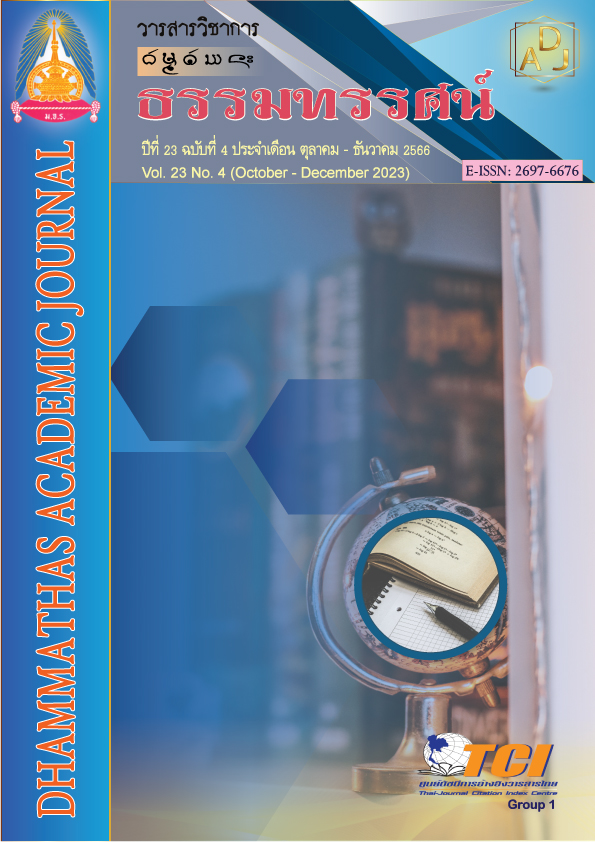The Integration of ITTHIPATA 4 with the New Theory Agriculture
Main Article Content
Abstract
The new theory agriculture is the principle of management of agricultural land and water for agriculture to gain maximum efficiency and benefits. It can enable farmers to produce four factors for their livelihoods consumption and all year round. Farmers can support themselves and generate income based on the principle of self-reliance, non-destructive natural resources, systematic planning of operations, and strengthening the family and community. Using the ITTHIPATA; 4 or to integrate with the new theory of agriculture increase the efficiency of farmers' operations to successfully plan objectives. It starts with CHANTA; which is the will or aspiration to work on agricultural farms with love and knowing how to plan and work systematically. Secondly, VIRIYA; is the energy and effort of farmers who are indomitable in the face of hardships in their work. They should have a responsibility in duty and control the work to be following the specified plan. Thirdly, CHITTA; is focusing active thought to achieve success, they should concentrate on work interests and gain new knowledge for self-improvement. Fourthly, VIMANGSA; is the use of intelligence to investigate operations, ponder, find reasons, improve and check operating procedures to develop strengths, and fix weaknesses to increase operational efficiency. If farmers integrate the 4 principles of basis for success to integrate with the new theory agriculture, they will be able to succeed in their goals with the willingness to do, focus on what they do, pay attention to what they do, and finally be confident in what you do. Farmers will be successful. The work process is more systematic and can generate more income for families and sustainable communities.
Article Details

This work is licensed under a Creative Commons Attribution-NonCommercial-NoDerivatives 4.0 International License.
เพื่อให้เป็นไปตามกฎหมายลิขสิทธิ์ ผู้นิพนธ์ทุกท่านต้องลงลายมือชื่อในแบบฟอร์มใบมอบลิขสิทธิ์บทความ ให้แก่วารสารฯ พร้อมกับบทความต้นฉบับที่ได้แก้ไขครั้งสุดท้าย นอกจากนี้ ผู้นิพนธ์ทุกท่านต้องยืนยันว่าบทความ ต้นฉบับที่ส่งมาตีพิมพ์นั้น ได้ส่งมาตีพิมพ์เฉพาะในวารสาร วิชาการธรรม ทรรศน์ เพียงแห่งเดียวเท่านั้น หากมีการใช้ ภาพหรือตารางของผู้นิพนธ์อื่นที่ปรากฏในสิ่งตีพิมพ์อื่นมาแล้ว ผู้นิพนธ์ต้องขออนุญาตเจ้าของลิขสิทธิ์ก่อน พร้อมทั้ง แสดงหนังสือที่ได้รับการยินยอมต่อบรรณาธิการ ก่อนที่บทความจะได้รับการตีพิมพ์References
กระทรวงเกษตรและสหกรณ์. (2539). พระบาทสมเด็จพระเจ้าอยู่หัวกับการพัฒนาเกษตรไทย. กรุงเทพฯ: อัมรินทร์พริ้นติ้ง แอน พับลิชชิ่ง.
พระพรหมคุณาภรณ์ (ป.อ.ปยุตฺโต). (2558). พจนานุกรมพุทธศาสตร์์ฉบับประมวลธรรม. (พิมพ์์ครั้งที่ 30). กรุงเทพฯ: มูลนิธิธรรมทานกุศลจิต.
พระมหาวีระศักดิ์ อภินนฺทเวที (แสงพงษ์). (2561). การบูรณาการหลักพุทธธรรมกับเกษตรทฤษฎีใหม่ของศาสตร์พระราชา. (วิทยานิพนธ์พุทธศาสตรดุษฎีบัณฑิต). พระนครศรีอยุธยา: มหาวิทยาลัยมหาจุฬาลงกรณราชวิทยาลัย.
พิสัณฑ์ โบว์สุวรรณ และคณะ. (2565). ปัญหาหนี้สินของเกษตรกรไทย. วารสารนวัตกรรมการศึกษาและการวิจัย, 6(1), 265-277.
พุทธทาสภิกขุ. (2537). การงานที่เป็นสุข. กรุงเทพฯ: ธรรมสภา.
มหาจุฬาลงกรณราชวิทยาลัย. (2539). พระไตรปิฎกภาษาไทย ฉบับมหาจุฬาลงกรณราชวิทยาลัย. กรุงเทพฯ: มหาจุฬาลงกรณราชวิทยาลัย.
สํานักงานคณะกรรมการพัฒนาเศรษฐกิจและสังคมแห่งชาติ. (2545). กรอบแนวทางแผนกลยุทธ์แก้ไขปัญหาความยากจน พ.ศ. 2545-2549. กรุงเทพฯ: สํานักนายกรัฐมนตรี.
สำนักงานคณะกรรมการพิเศษเพื่อประสานงานโครงการอันเนื่องมาจากพระราชดำริ (สำนักงาน กปร.). (2555). จอมปราชญ์แห่งการพัฒนาทฤษฎีใหม่. กรุงเทพฯ: อัมรินทร์พริ้นติ้ง แอน พับลิชชิ่ง.
สำนักงานปลัดนายกรัฐมนตรี. (2543). โครงการรวมน้ำ+ใจ ถวายในหลวง. กรุงเทพฯ: ทรีดิเอชั่น.

